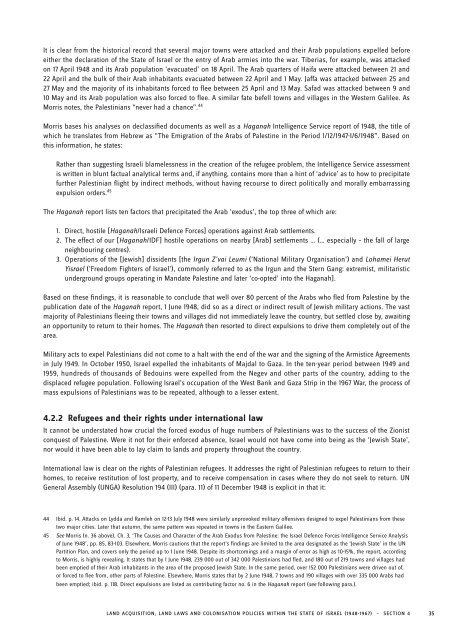Ruling Palestine
You also want an ePaper? Increase the reach of your titles
YUMPU automatically turns print PDFs into web optimized ePapers that Google loves.
It is clear from the historical record that several major towns were attacked and their Arab populations expelled before<br />
either the declaration of the State of Israel or the entry of Arab armies into the war. Tiberias, for example, was attacked<br />
on 17 April 1948 and its Arab population ‘evacuated’ on 18 April. The Arab quarters of Haifa were attacked between 21 and<br />
22 April and the bulk of their Arab inhabitants evacuated between 22 April and 1 May. Jaffa was attacked between 25 and<br />
27 May and the majority of its inhabitants forced to flee between 25 April and 13 May. Safad was attacked between 9 and<br />
10 May and its Arab population was also forced to flee. A similar fate befell towns and villages in the Western Galilee. As<br />
Morris notes, the Palestinians “never had a chance”. 44<br />
Morris bases his analyses on declassified documents as well as a Haganah Intelligence Service report of 1948, the title of<br />
which he translates from Hebrew as “The Emigration of the Arabs of <strong>Palestine</strong> in the Period 1/12/1947-1/6/1948”. Based on<br />
this information, he states:<br />
Rather than suggesting Israeli blamelessness in the creation of the refugee problem, the Intelligence Service assessment<br />
is written in blunt factual analytical terms and, if anything, contains more than a hint of ‘advice’ as to how to precipitate<br />
further Palestinian flight by indirect methods, without having recourse to direct politically and morally embarrassing<br />
expulsion orders. 45<br />
The Haganah report lists ten factors that precipitated the Arab ‘exodus’, the top three of which are:<br />
1. Direct, hostile [Haganah/Israeli Defence Forces] operations against Arab settlements.<br />
2. The effect of our [Haganah/IDF] hostile operations on nearby [Arab] settlements … (… especially – the fall of large<br />
neighbouring centres).<br />
3. Operations of the [Jewish] dissidents [the Irgun Z’vai Leumi (‘National Military Organisation’) and Lohamei Herut<br />
Yisrael (‘Freedom Fighters of Israel’), commonly referred to as the Irgun and the Stern Gang: extremist, militaristic<br />
underground groups operating in Mandate <strong>Palestine</strong> and later ‘co-opted’ into the Haganah].<br />
Based on these findings, it is reasonable to conclude that well over 80 percent of the Arabs who fled from <strong>Palestine</strong> by the<br />
publication date of the Haganah report, 1 June 1948, did so as a direct or indirect result of Jewish military actions. The vast<br />
majority of Palestinians fleeing their towns and villages did not immediately leave the country, but settled close by, awaiting<br />
an opportunity to return to their homes. The Haganah then resorted to direct expulsions to drive them completely out of the<br />
area.<br />
Military acts to expel Palestinians did not come to a halt with the end of the war and the signing of the Armistice Agreements<br />
in July 1949. In October 1950, Israel expelled the inhabitants of Majdal to Gaza. In the ten-year period between 1949 and<br />
1959, hundreds of thousands of Bedouins were expelled from the Negev and other parts of the country, adding to the<br />
displaced refugee population. Following Israel’s occupation of the West Bank and Gaza Strip in the 1967 War, the process of<br />
mass expulsions of Palestinians was to be repeated, although to a lesser extent.<br />
4.2.2 Refugees and their rights under international law<br />
It cannot be understated how crucial the forced exodus of huge numbers of Palestinians was to the success of the Zionist<br />
conquest of <strong>Palestine</strong>. Were it not for their enforced absence, Israel would not have come into being as the ‘Jewish State’,<br />
nor would it have been able to lay claim to lands and property throughout the country.<br />
International law is clear on the rights of Palestinian refugees. It addresses the right of Palestinian refugees to return to their<br />
homes, to receive restitution of lost property, and to receive compensation in cases where they do not seek to return. UN<br />
General Assembly (UNGA) Resolution 194 (III) (para. 11) of 11 December 1948 is explicit in that it:<br />
44 Ibid. p. 14. Attacks on Lydda and Ramleh on 12-13 July 1948 were similarly unprovoked military offensives designed to expel Palestinians from these<br />
two major cities. Later that autumn, the same pattern was repeated in towns in the Eastern Galilee.<br />
45 See Morris (n. 36 above), Ch. 3, ‘The Causes and Character of the Arab Exodus from <strong>Palestine</strong>: the Israel Defence Forces Intelligence Service Analysis<br />
of June 1948’, pp. 85, 83-103. Elsewhere, Morris cautions that the report’s findings are limited to the area designated as the ‘Jewish State’ in the UN<br />
Partition Plan, and covers only the period up to 1 June 1948. Despite its shortcomings and a margin of error as high as 10-15%, the report, according<br />
to Morris, is highly revealing. It states that by 1 June 1948, 239 000 out of 342 000 Palestinians had fled, and 180 out of 219 towns and villages had<br />
been emptied of their Arab inhabitants in the area of the proposed Jewish State. In the same period, over 152 000 Palestinians were driven out of,<br />
or forced to flee from, other parts of <strong>Palestine</strong>. Elsewhere, Morris states that by 2 June 1948, 7 towns and 190 villages with over 335 000 Arabs had<br />
been emptied; ibid. p. 118. Direct expulsions are listed as contributing factor no. 6 in the Haganah report (see following para.).<br />
LAND ACQUISITION, LAND LAWS AND COLONISATION POLICIES WITHIN THE STATE OF ISRAEL (1948-1967) — SECTION 4 35



